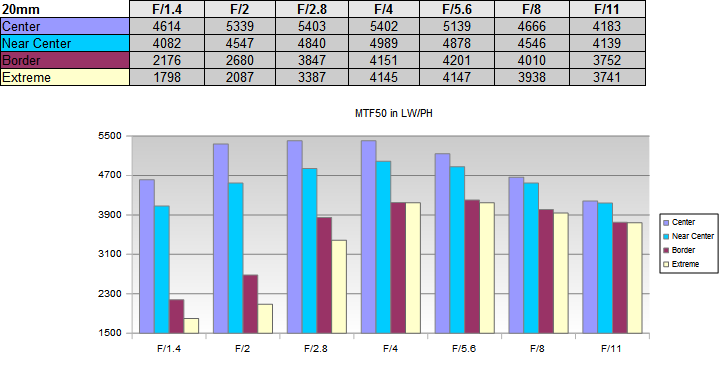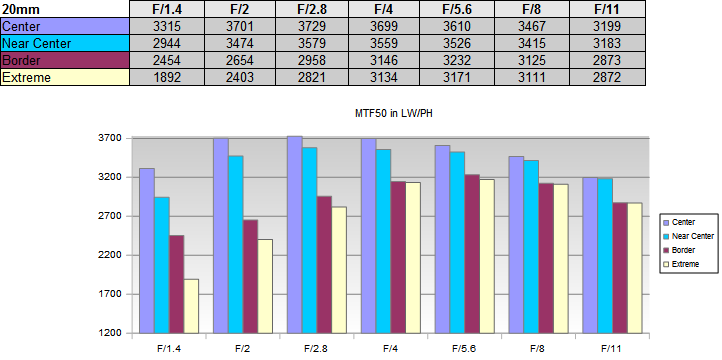|
Sigma 20mm f/1.4 DG HSM | A ("Art") - Full Format Review / Lens Test - Analysis |
|
Lens Reviews -
Canon EOS (Full Format)
|
|
Page 2 of 2

Distortion
The lens produces a medium amount of barrel distortion (2.4%), which is about average (in the true sense) in this class. It is, however, worth mentioning that many ultra-wide zoom lenses tend to distort less at their 20mm setting.

Vignetting
Very fast and wide lenses are prone to heavy vignetting at large apertures, and despite its size, the Sigma can't hide from the realities here as well. Wide open, there is an extreme amount of light falloff (3.3EV). As usual, stopping down reduces the amount of vignetting considerably. At f/2.8, the vignetting is already down to very moderate levels and from f/4 onward, it should no longer be an issue for most scenes.

MTF (resolution) on the EOS 5Ds R (at 50 megapixels)
This time we have reviewed the lens on both the EOS 5Ds R (50 megapixels) as well as the old EOS 5D II (21 megapixels). Let's have a look at the 50mp results first.
Given the extreme resolution of the sensor and the type of lens, the Sigma lens is capable of delivering fairly impressive results, albeit not without issues. As with most high-quality prime lenses, it has no problems in the image center, which is very sharp at f/1.4 and outstanding at medium apertures. The "near-center" quality is also very high, peaking at excellent levels. Unsurprisingly things go downhill at the borders/corners. At f/1.4 and f/2, the results are very soft. To be fair, though - it is a question of whether sharp corners/borders are really relevant at these settings. The outer region improves drastically to good levels at f/2.8, and it even manages to achieve very good results between f/4-f/8. Diffraction has a higher impact from f/11 onward.
The centering quality of the tested sample was very good.
Below is a simplified summary of the formal findings. The chart shows line widths
per picture height (LW/PH) which can be taken as a measure of sharpness.
If you want to know more about the MTF50 figures, you may check out the corresponding
Imatest Explanations

MTF (resolution) on the EOS 5D II (at 21 megapixels)
Many readers are, of course, still interested in the performance on more sane cameras, so we gave it a try again on our previous test camera.
Unsurprisingly the results are very different. Before going into the details, please allow us some explanations first. The EOS 5Ds R and EOS 5D II are drastically different beasts. They do have not only different sensors, but also different sensor filters (in fact, the 5Ds R has no AA filter) and different in-camera post-processing. The EOS 5Ds also has a substantially higher sensor noise level. We are also calibrating the RAW processing to achieve "neutral" sharpening meaning that the processed image is neither over- nor undersharpened as far as the highest resolution spot is concerned. On top of that come related effects to all this from the software used for the analysis. Thus - as we always said and continue to repeat - results from different test systems are not directly comparable (which is most obvious at f/1.4 and f/2). However, the aspect that will not change is the ranking. A lens A that is better than lens B will also remain better when moving towards a different test bed.
Unsurprisingly the results are much "denser" than on the EOS 5Ds R, meaning that the difference between center and borders isn't quite as pronounced. The center quality remains exceedingly high, of course. The corners are still not great at f/1.4 and f/2, but at least at f/2 they are acceptable. Stopping down to f/2.8 is improving the quality further, but the truly impressive results kick in at f/4 where the quality is about as good as it gets - across all tested lenses, that is. That alone is already astonishing considering the fact that we are talking about an ultra-wide lens here, but it's actually mind-blowing when keeping in mind that this is an f/1.4 lens. Ultra-fast lenses tend to be worse than their more moderate counterparts, but the Sigma negates this logic.
Please note that the MTF results are not directly comparable across the different systems!
Below is a simplified summary of the formal findings. The chart shows line widths per picture height (LW/PH) which can be taken as a measure of sharpness.
If you want to know more about the MTF50 figures, you may check out the corresponding Imatest Explanations

Chromatic Aberrations (CAs)
Chromatic aberrations (color shadows at harsh contrast transitions) are well-controlled, showing readings below an average pixel width of 1px at the image borders. This is the result on the 5Ds R - it's much less than that on a 21mp sensor, of course.

Bokeh
We don't really do a full formalized bokeh tests on wide lenses, but we'd like to give you an idea here at least. Despite offering a max. aperture of f/1.4, you shouldn't really expect a massive amount of foreground/background blur unless your main subject is comparatively close. However, the fact remains that this capability is one of the primary value propositions of the Sigma lens.
The good news is that it is far(!) better than most wide-angle lenses in this respect.
Below is a sequence of out-of-focus highlights. The inner highlight discs are quite clean, although you may spot traces of an onion-like sub-structure. The amount of highlight outlining is moderate. Again - this has to be seen in the context of its lens class, and the result is actually impressive.
 The quality of those highlight discs is, of course, diminishing towards the image corners. The next image shows a "worst-case" crop which illustrates the issue. Please note that while this may not look pleasing, it is completely normal (a vignetting effect).
The quality of those highlight discs is, of course, diminishing towards the image corners. The next image shows a "worst-case" crop which illustrates the issue. Please note that while this may not look pleasing, it is completely normal (a vignetting effect).
 In order to give you a more real-life impression of the general blur, here's another crop that shows how good the Sigma is at rendering the focus transition zones. Please note that this image portion was taken near the center. There's some bokeh smearing in the image corners, but even so, the quality is much better than average.
In order to give you a more real-life impression of the general blur, here's another crop that shows how good the Sigma is at rendering the focus transition zones. Please note that this image portion was taken near the center. There's some bokeh smearing in the image corners, but even so, the quality is much better than average.

Sample Images
At the time we wanted to do the field tests, we had very bad weather conditions. Thus we only have a sample from the initial verification.
Verdict
Nothing is perfect, and that also applies to the Sigma 20mm f/1.4 DG HSM | Art. HOWEVER, in the grand scheme of things, the lens is very impressive! Ultra-wide lenses are already difficult to design but developing a 20mm f/1.4 lens of acceptable quality is tough, really tough, which tells a lot about Sigma's capabilities.
The Canon EOS 5Ds R proved, once again, to be a challenging test bed. However, the Sigma lens is able to exploit most of this potential in the image center straight from the max. aperture. The outer image region is a different topic, of course. The results are very soft here till f/2, and they only become acceptable at f/2.8. However, from f/4 onward, it's a different topic with very good results across the image field.
The performance is, of course, much more impressive when using cameras with a more moderate pixel density. On a 21mp DSLR, you can expect decent results at f/2 and outstanding results around the sweet spot at f/5.6.
Typical for its class, you have to live with very high vignetting at f/1.4 and f/2. However, if you compare the results with a zoom lens at identical aperture settings - thus from f/2.8 or f/4 onward - you will be impressed. Image distortions are visible in critical scenes, but they remain on a rather moderate level. Lateral CAs aren't relevant except in the extreme corners.
A really nice aspect of the Sigma lens is the quality of the bokeh. Of course, ultra-wide lenses cannot compete with Tele lenses in this respect, but the smoothness is more than decent relative to competing lenses.
The build quality is, by now, a no-brainer when it comes to Sigma Art series lenses. It is clearly up to professional standards ... except for the lack of weather sealing. AF speed isn't a primary aspect of a 20mm lens, but Sigma's HSM does a pretty fast and silent job here.
There's little doubt that the Sigma is one of the best lenses in its class. Even so, the EOS 5Ds R remains a tough dog, and the Sigma can't crack the achievable quality in the outer image field. However, at medium aperture settings, it comes close at least. On less extreme cameras, the quality is more obvious, and we have no problem granting our "Highly recommended" rating here.
| Optical Quality at 50 megapixels: | No rating at this stage | | |
| Optical Quality at 21 megapixels: |  |
 |
| Mechanical Quality: |  |
| Price/Performance: |  |
| | |
| | What does this mean ? |
|
|